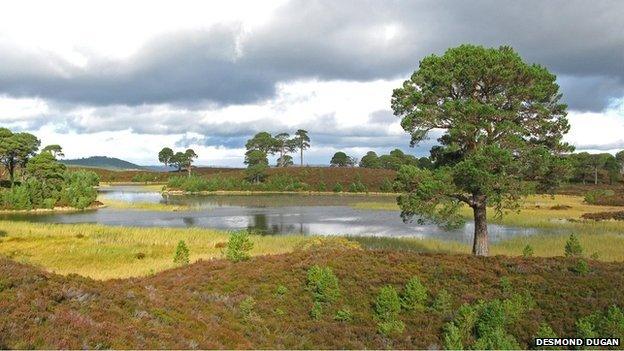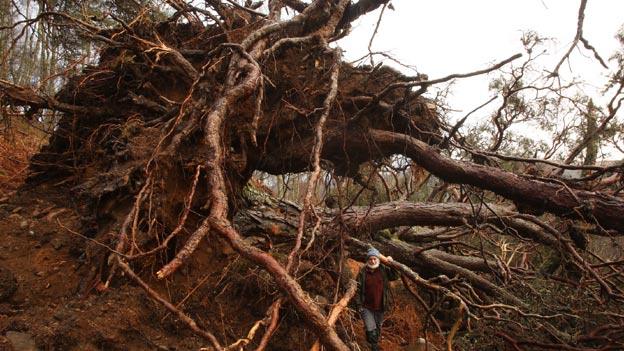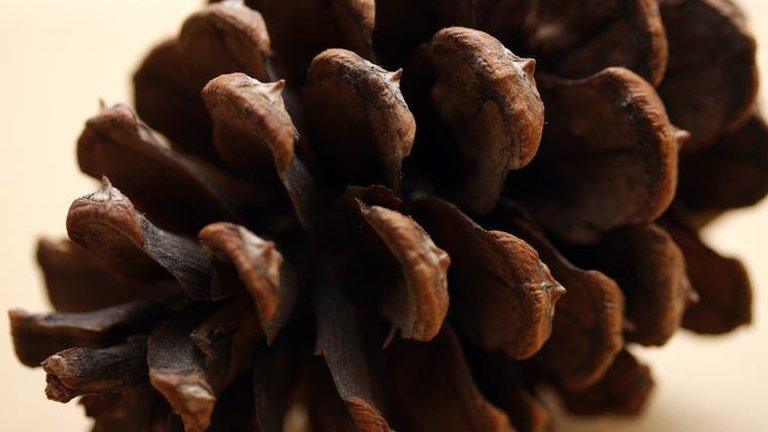Work to restore Caledonian forest in Speyside
- Published

The aim is to eventually connect up remnants of the ancient Caledonian pine forest
Work has begun on a scheme to restore native Caledonian pine forest in Speyside, which will involve planting almost 100,000 trees.
The project is focused on the RSPB's Abernethy Forest nature reserve.
The aim is to expand the largest single remnant of ancient Caledonian pine forest, connecting it to other remnants of the forest nearby.
Conservationists said that would create a much larger habitat for woodland species.
But the project faced criticism from Ramblers Scotland which said it could damage the ecological and recreational value in and around the old Caledonian forest.
Abernethy is home to capercaillie, Scottish crossbills, crested tits, wildcats, pine marten, black grouse, golden eagles and many rare mosses, fungi and plants.
RSPB Scotland said work over the past 25 years to reduce grazing pressure from deer had already resulted in the natural regeneration of Scots pine.
'Schools and volunteers'
But the environmental organisation warns that native shrub and broadleaved species, such as juniper, birch, rowan, alder and willow, have been slower to recover.
These species are regarded as a "critical element" of the ecology of Caledonian pine forest.
Jeremy Roberts, the senior site manager at Abernethy, said: "We have conducted some of the most comprehensive surveys of regeneration in Britain, and this has shown that the recovery of broadleaves has been extremely slow and localised compared to the pine element at Abernethy.
"To give the forest a helping hand we are restoring these species, with the welcome help of local schools and volunteers to assist with the planting of these under-represented broadleaved trees.
"As these small groups mature they will themselves provide the seed source, inoculating the forest edge and providing a locus for these species to regenerate more widely, and restoring the forest to its diverse and species-rich former glory."
But Ramblers Scotland director, Dave Morris, said: "We welcome efforts to extend native pinewoods by planting, but planting in and around the old Caledonian forest damages its ecological and recreational value.
"The pinewoods have descended from the last ice age through natural regeneration.
"In these special areas the restoration of the forest should be by natural seeding from the existing trees, not by planting."
Environment Minister Paul Wheelhouse said: "The RSPB should be congratulated for taking forward this pioneering project.
"It fits very well with the Scottish government's vision for woodland expansion and community engagement.
"It is also great news that Scotland's national tree, the Scots pine, is doing so well in Abernethy Forest. The move to plant more tree species in the forest is a positive one which will add great value to the environmental quality and biodiversity of the Cairngorms."
Giles Brockman, environment manager of Forestry Commission Scotland, said: "The regeneration of the native woodland on the National Forest Estate, in Queen's Forest at Glenmore Forest Park, is steadily making its way up and over the mountains from the south west of the Ryvoan Pass, so we'll see the two forests continue to join up.
"The Abernethy project will give a great boost to the native woodland from the north east, so will see the two forests join up over the next 200 years."
Private estates and other environmental organisations are working on similar projects elsewhere in Scotland.
These include Trees for Life, The National Trust of Scotland at Mar Lodge, Scottish Natural Heritage (SNH), Forestry Commission Scotland (FCS) and estate managers at Alladale and Glen Feshie.
Consent for the Abernethy project was granted by SNH, FCS and the Cairngorms National Park Authority after a period of consultation and the completion of an Environmental Impact Assessment.
- Published7 February 2014

- Published23 July 2012

- Published27 April 2012
